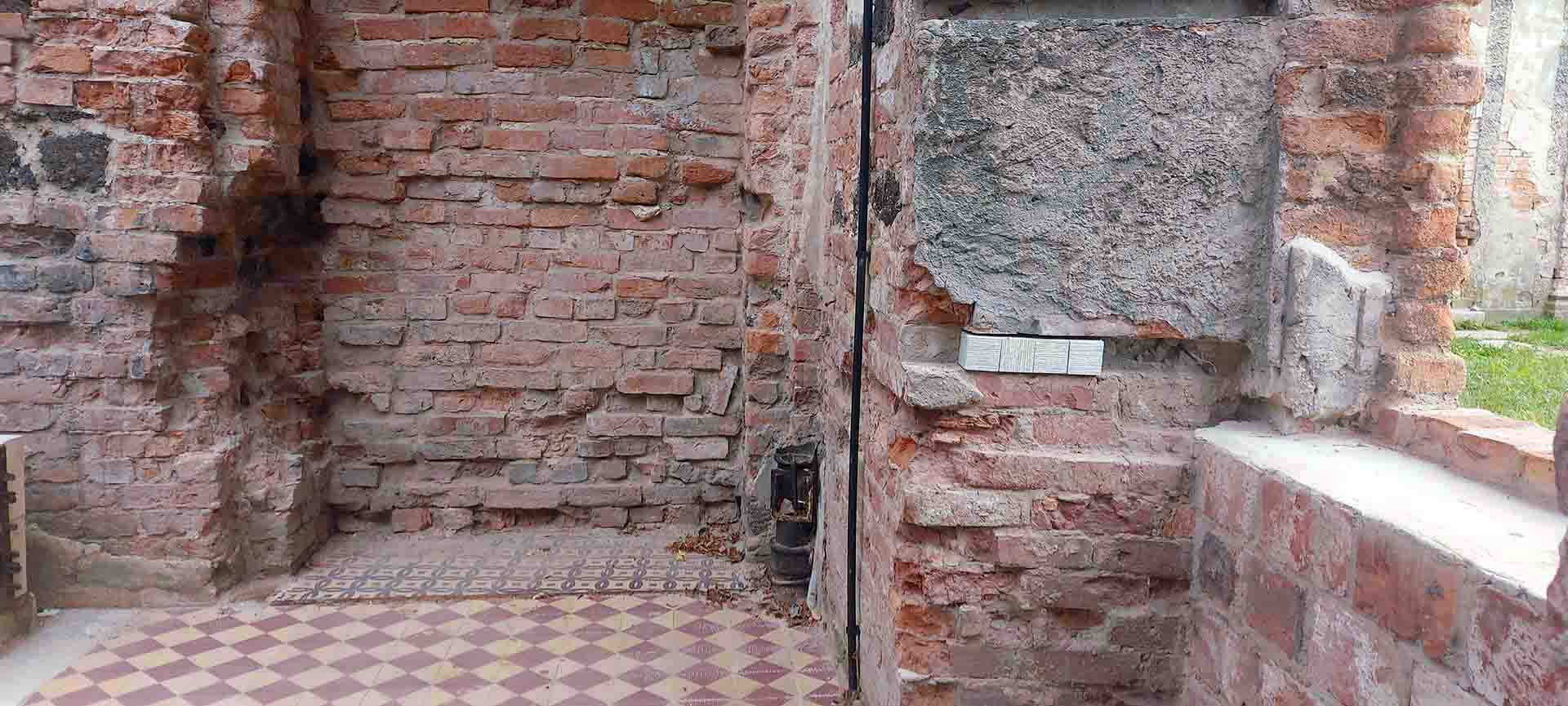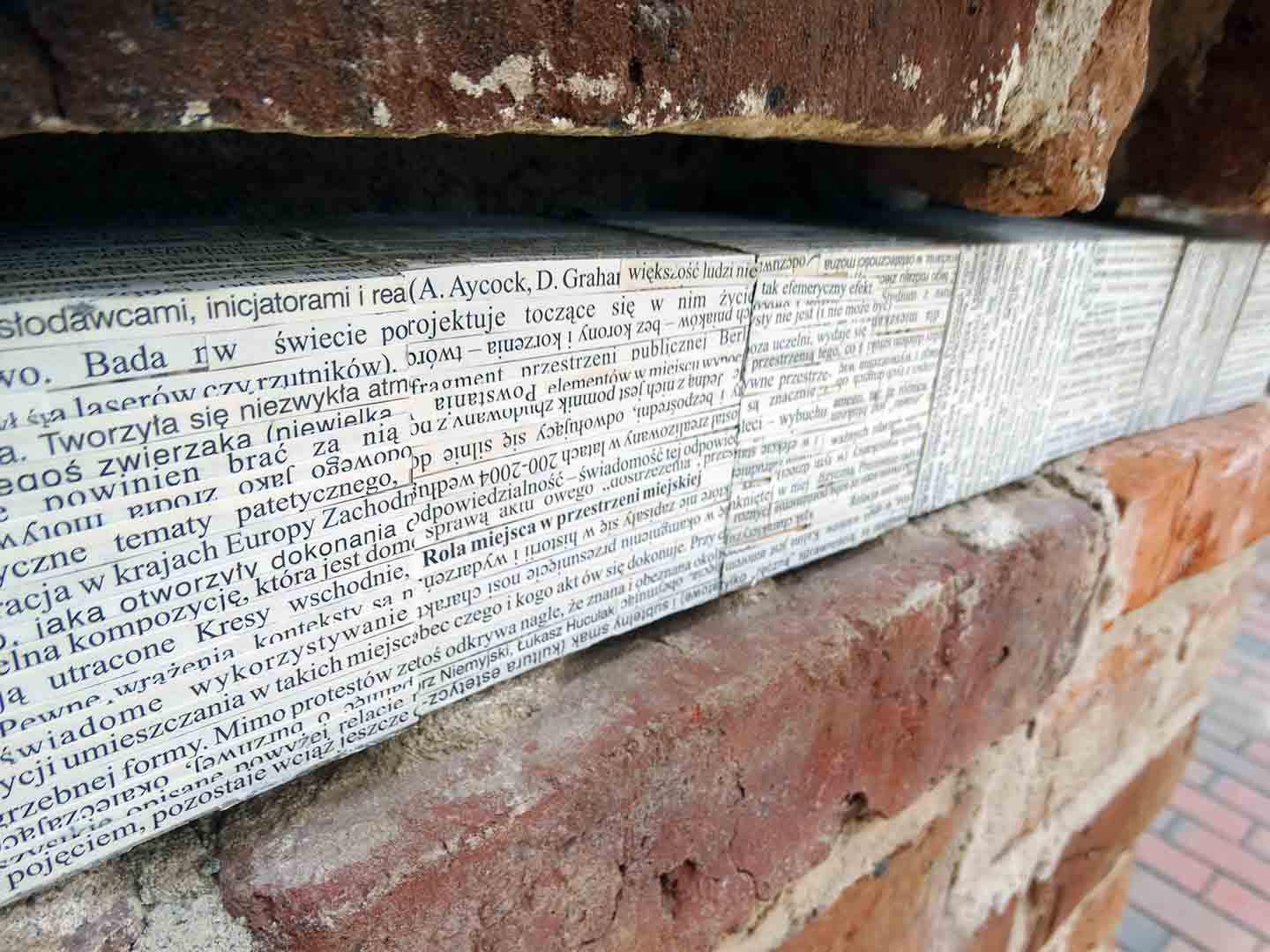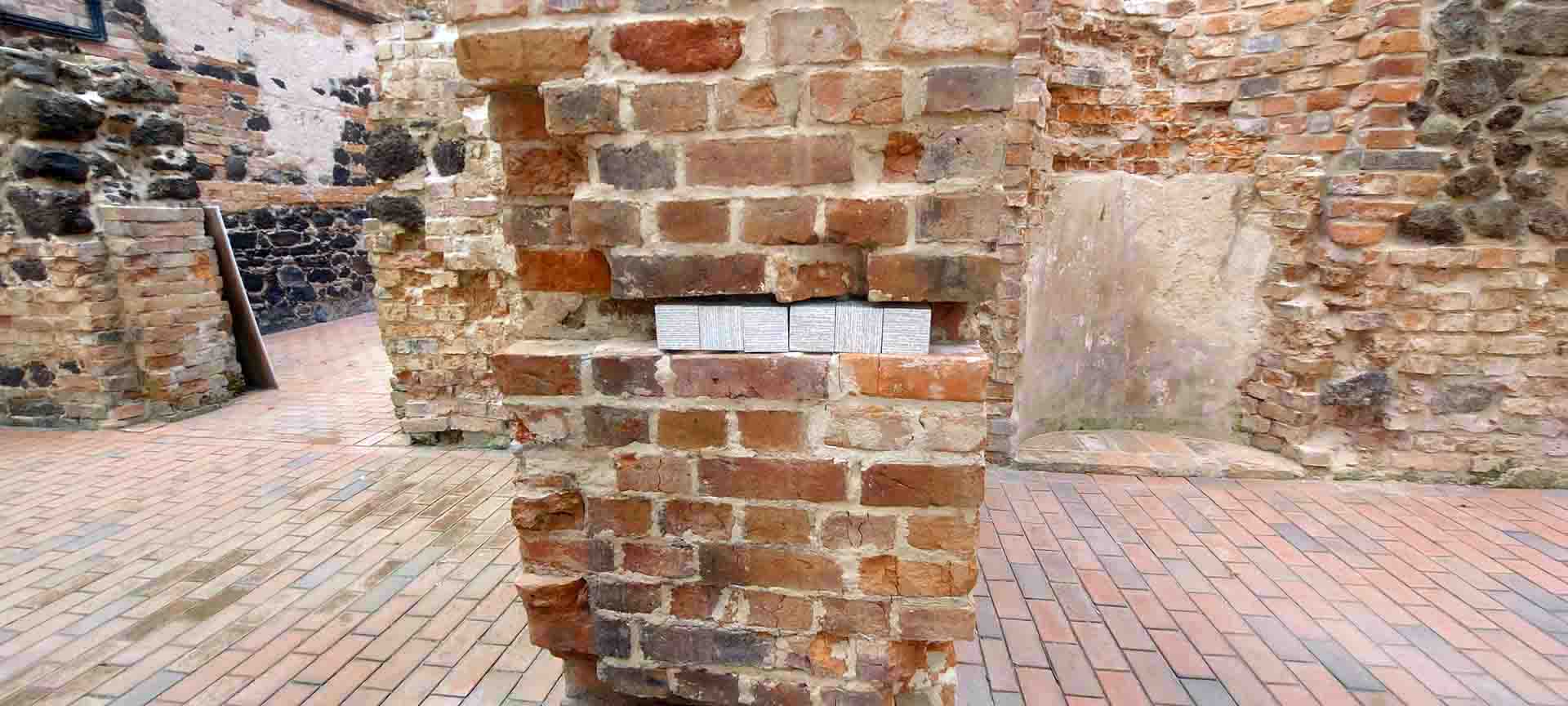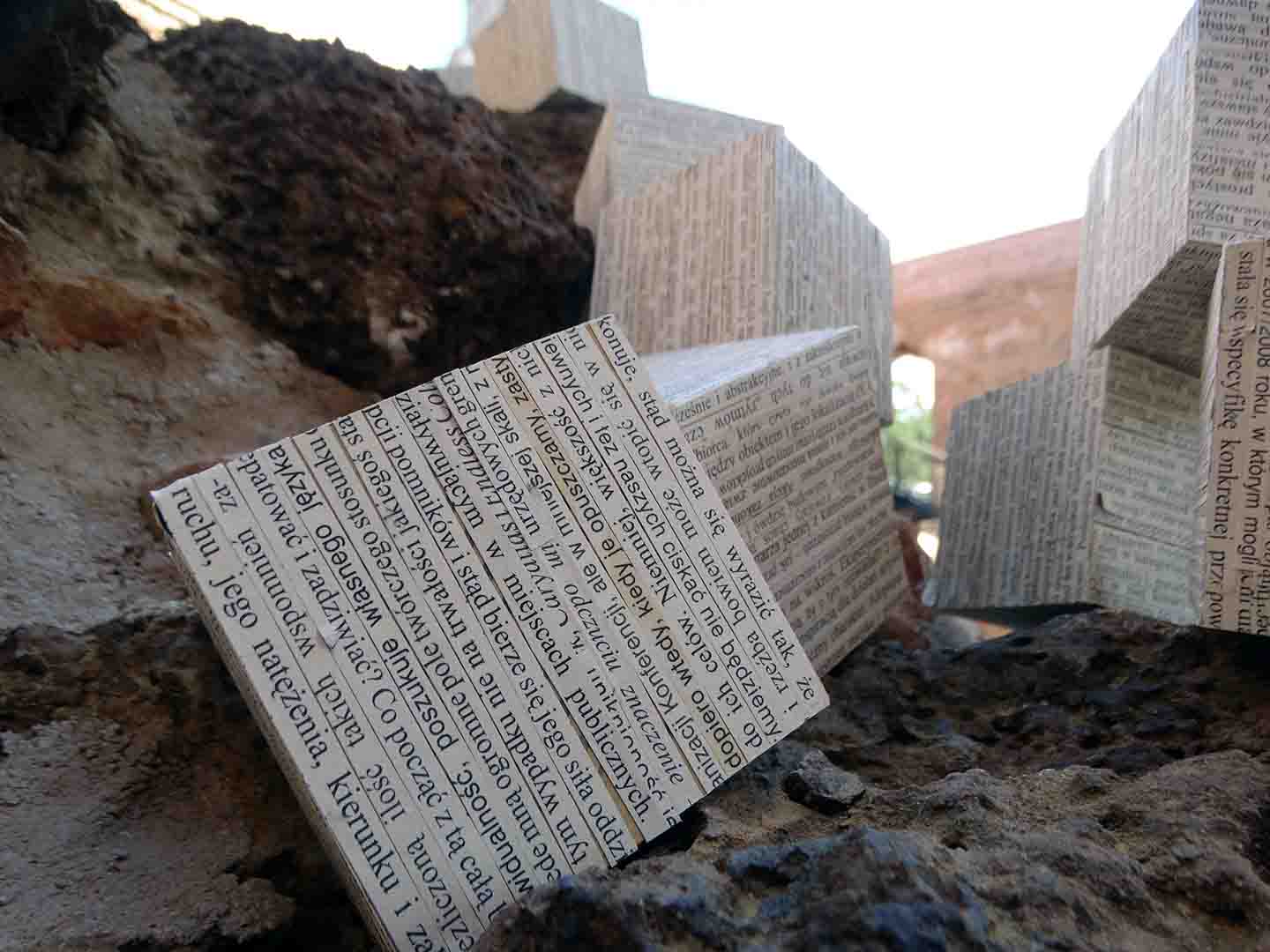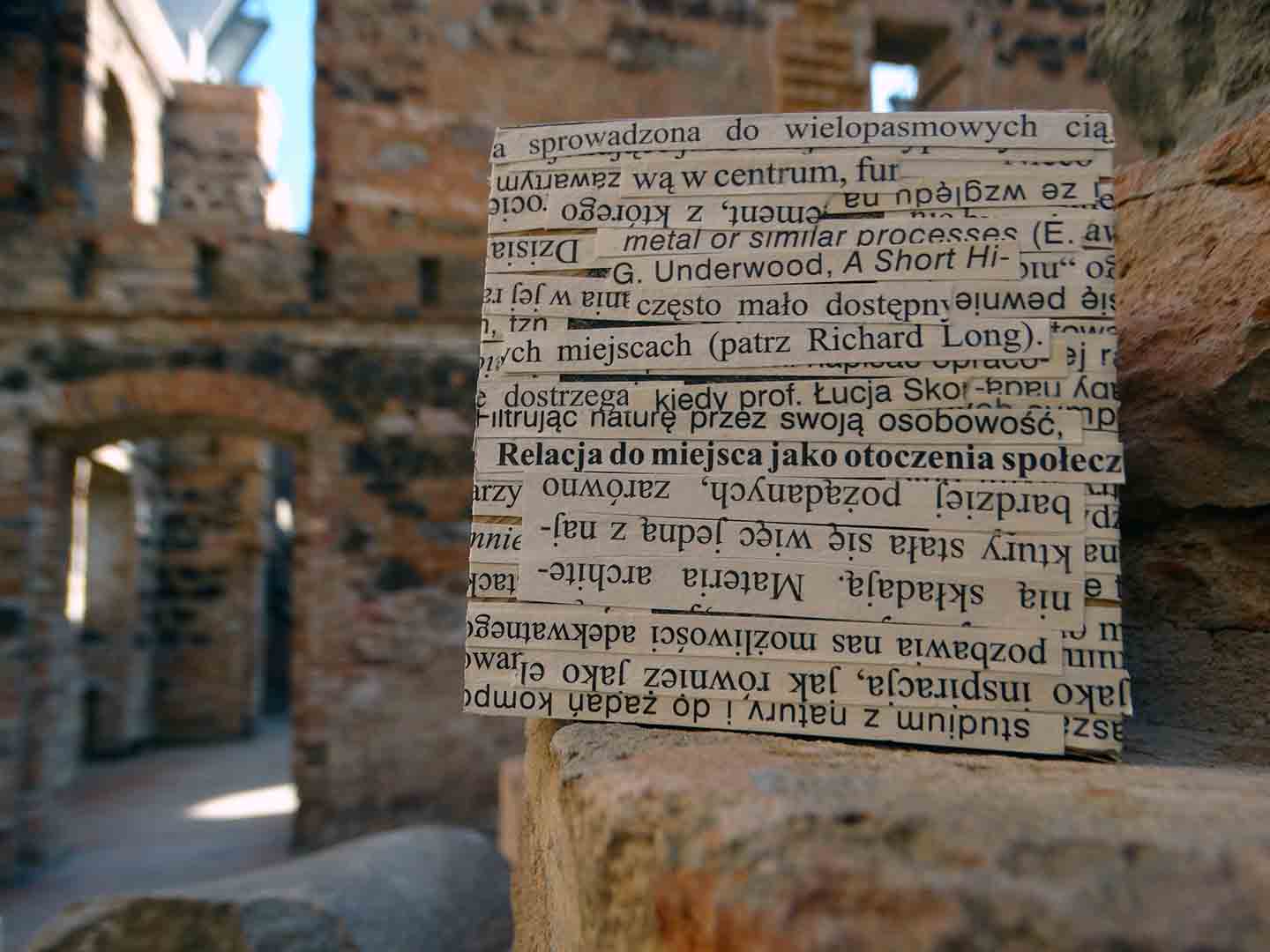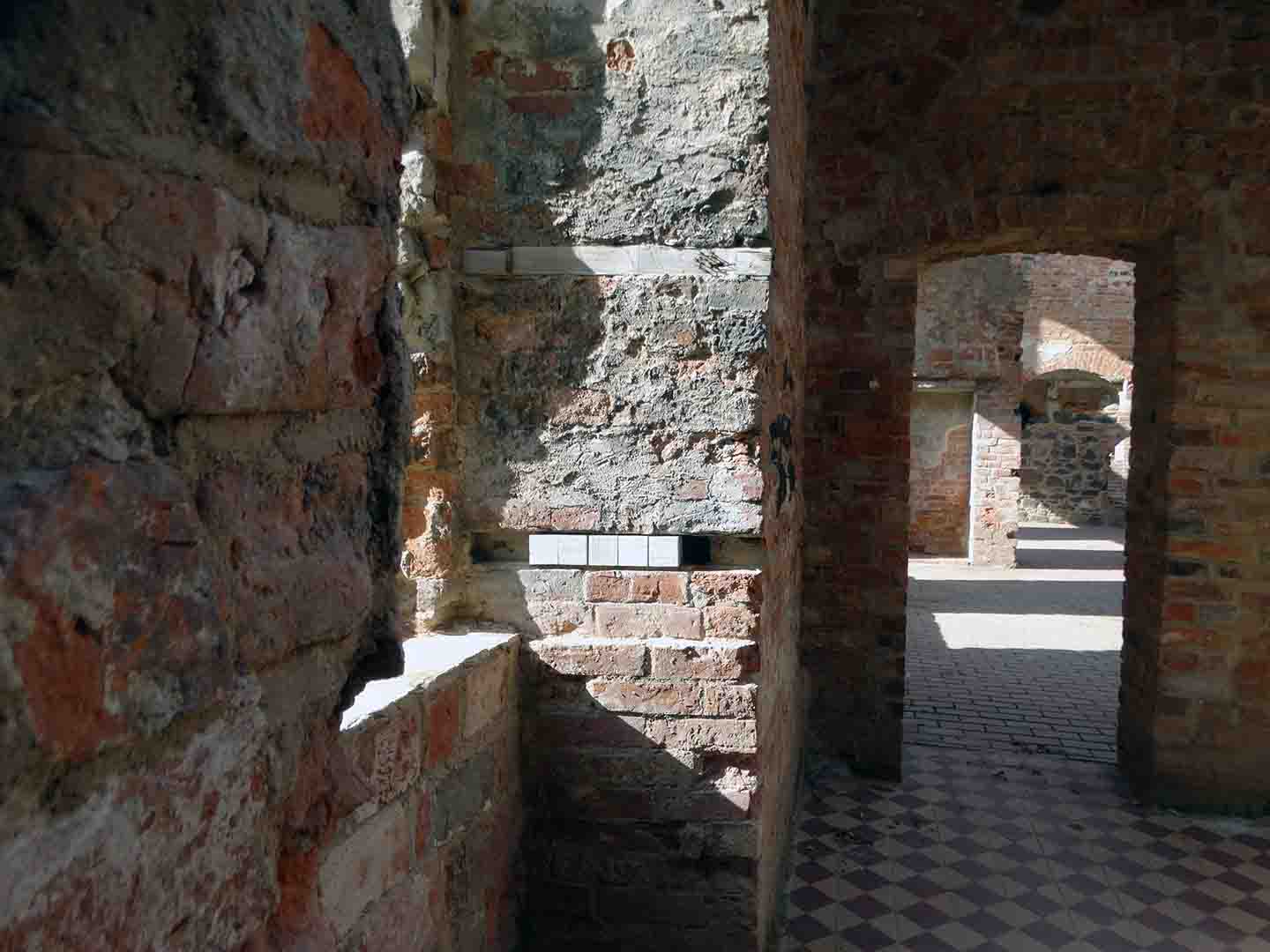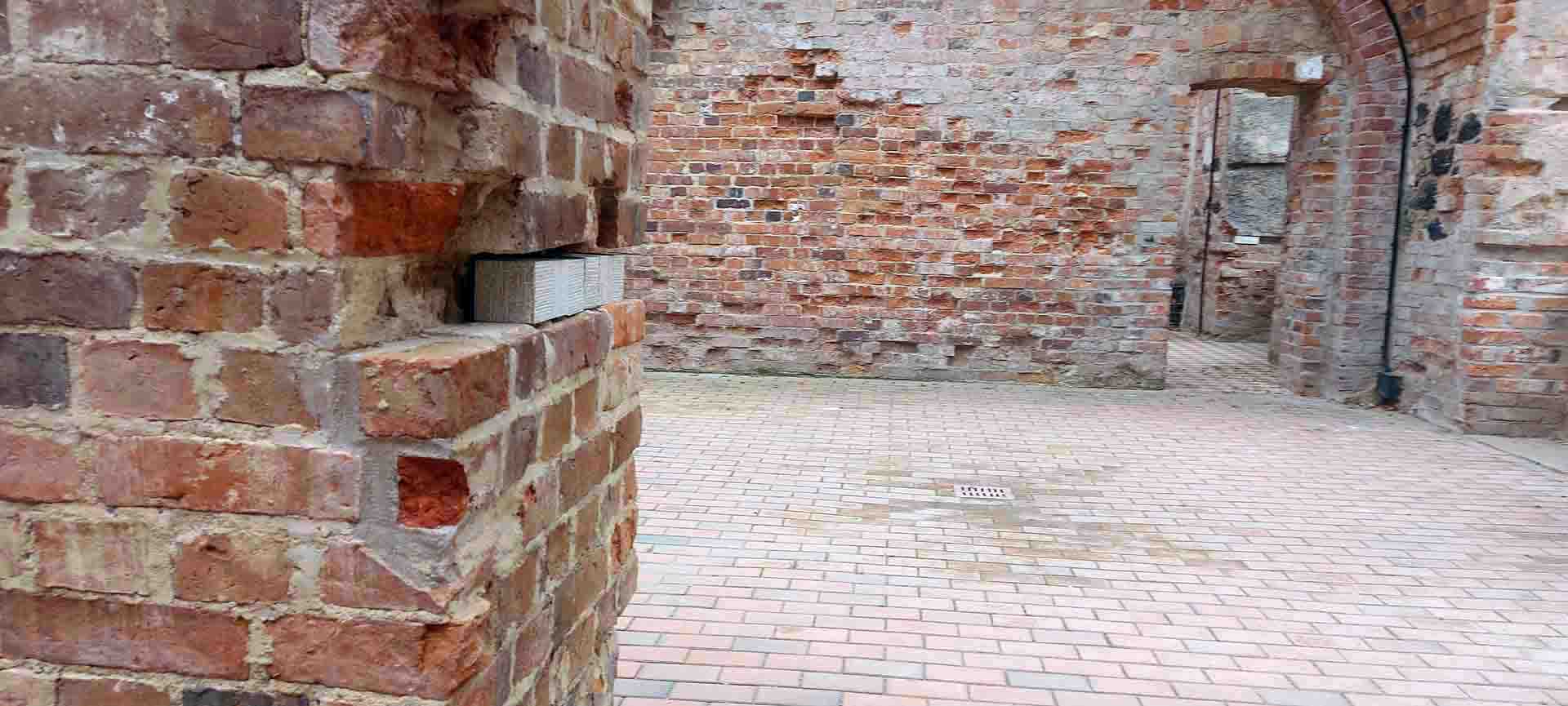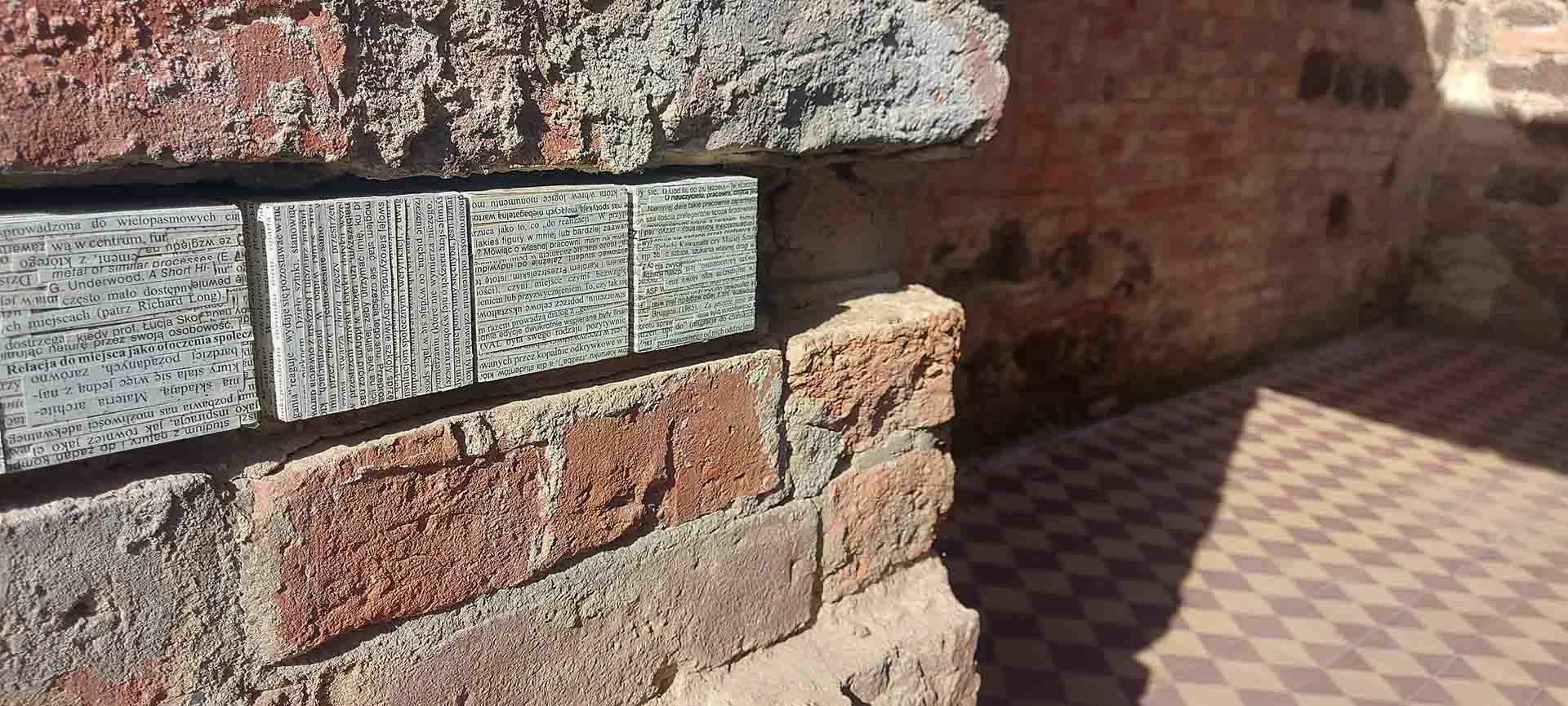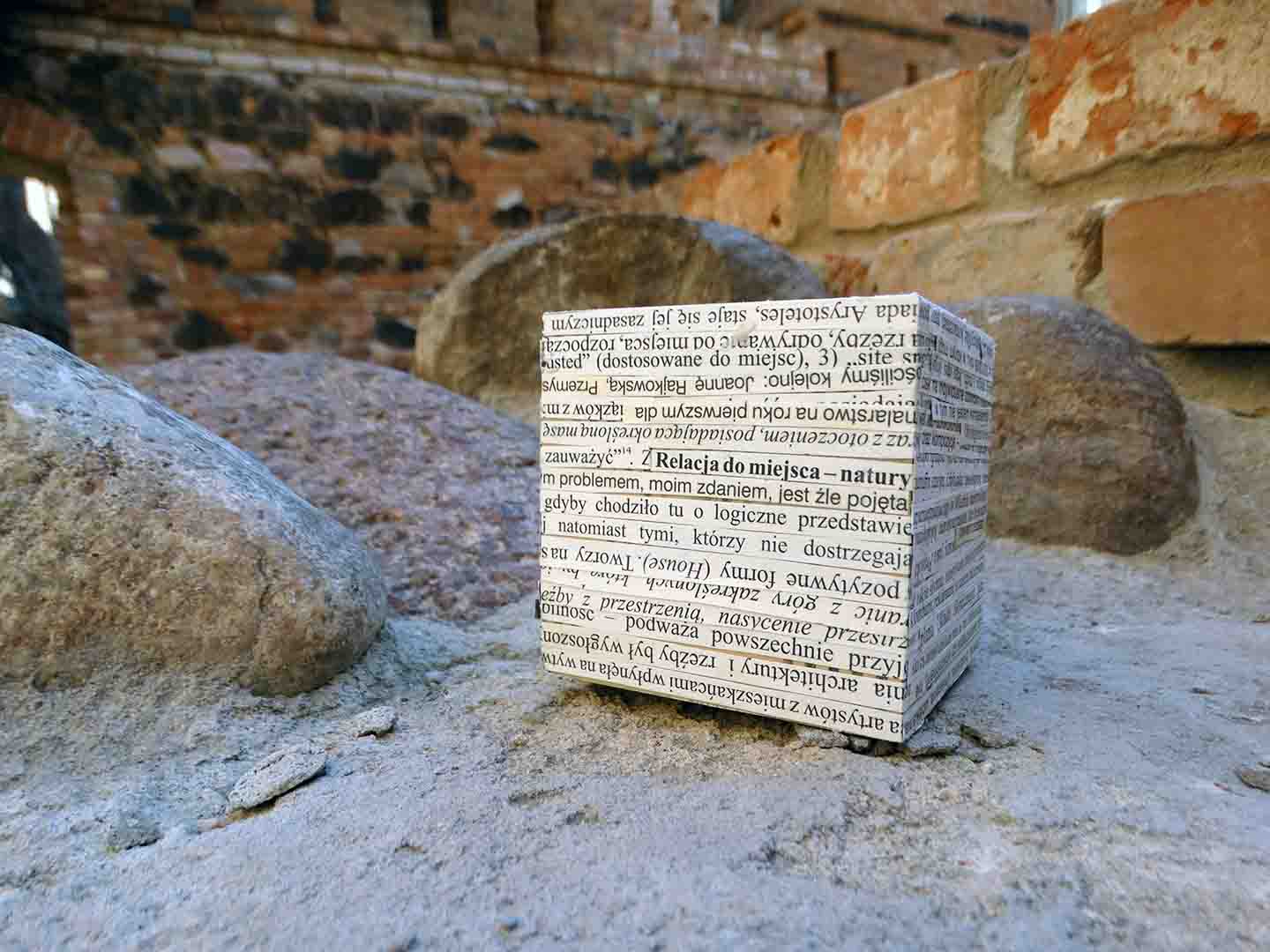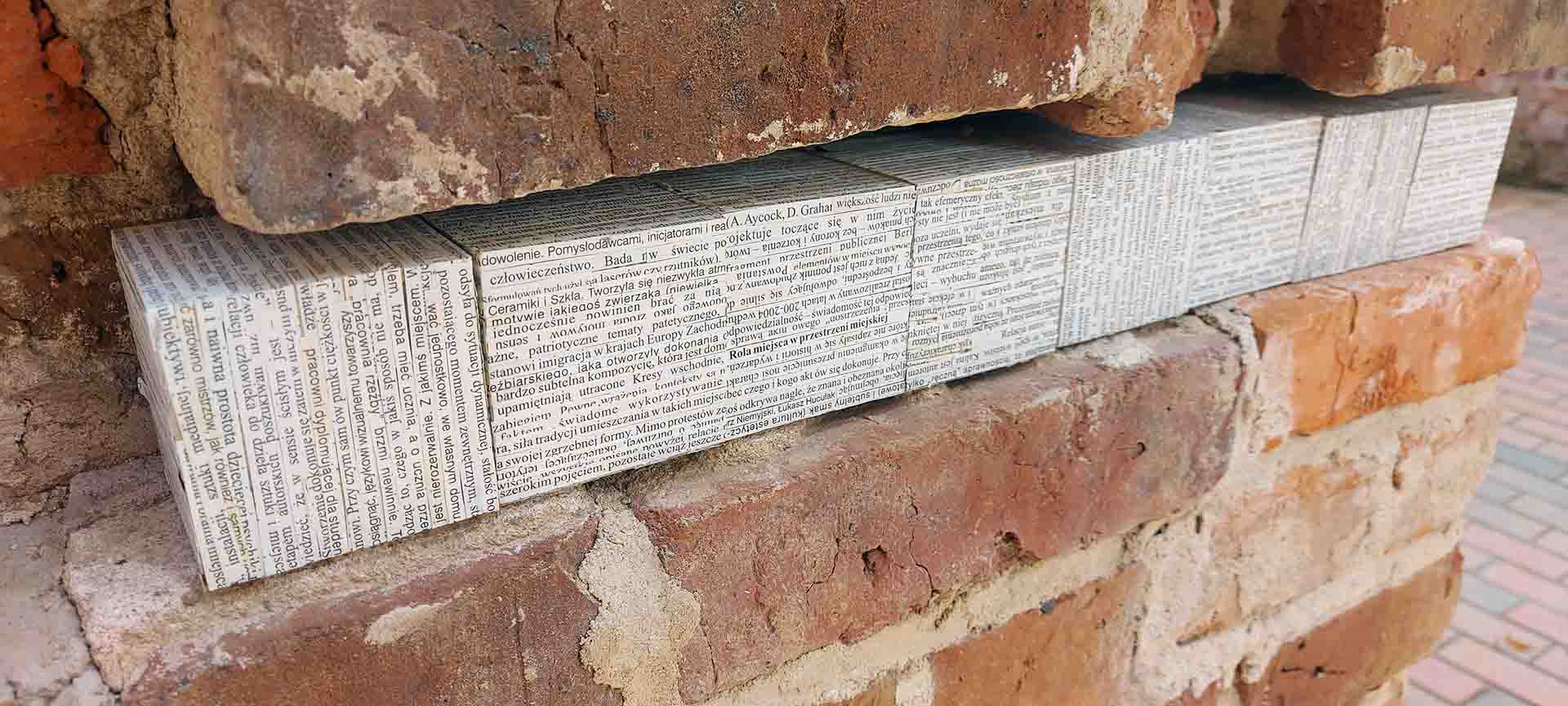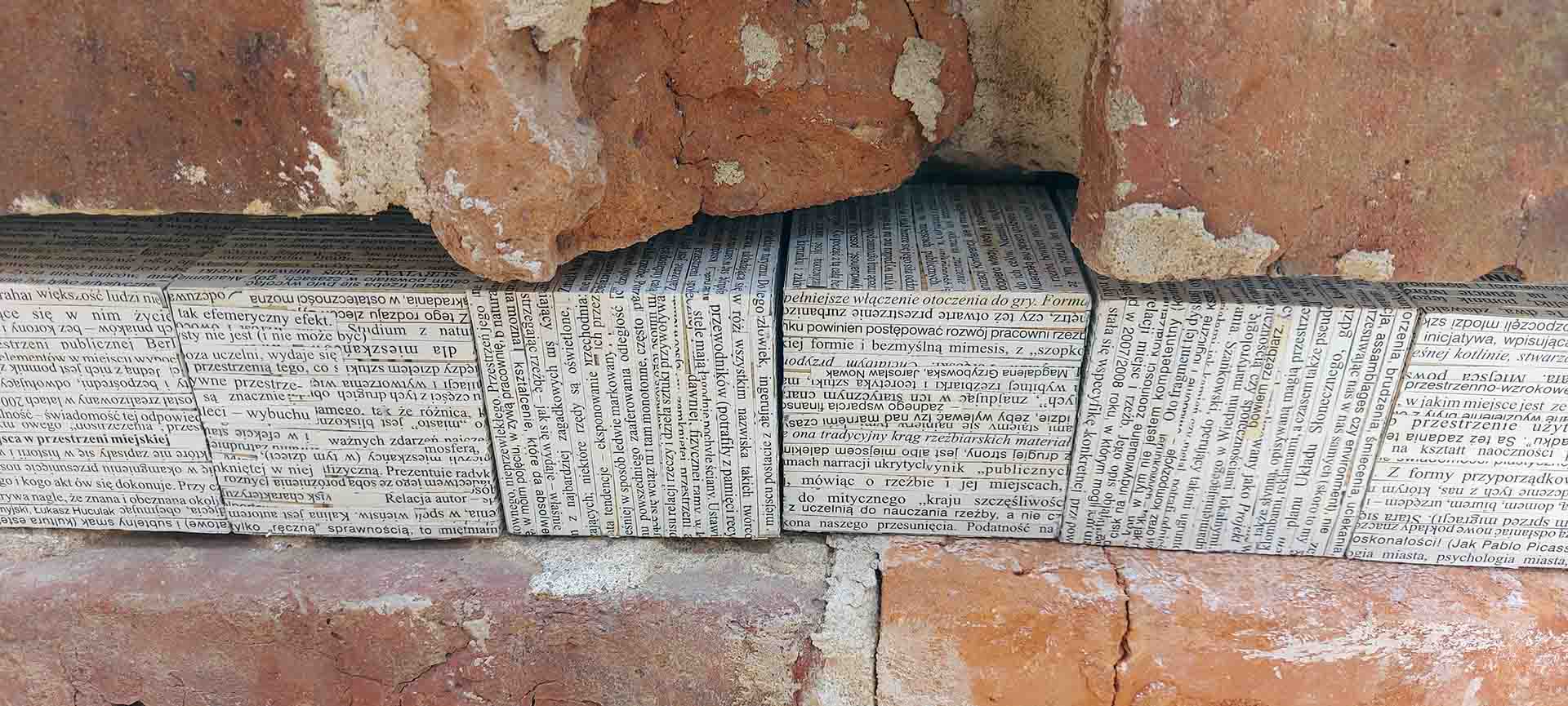SCULPTURE IN PLACE _ CUBES
Works from the series: Asemic Writing "SCULPTURE IN PLACE _ CUBES", 2023 | Prace z cyklu: Asemic Writing "RZEŹBA W MIEJSCU_CUBES", 2023
Object, 9 pieces, 7 × 7 × 7 cm, wooden cubes covered with print on paper | Obiekt, 9 sztuk, 7×7×7 cm, kostki drewniane pokryte nadrukiem na papierze
[ENG]
Asemic Writing: SCULPTURE IN PLACE _ CUBES (2023)
I created the project “RZEŹBA W MIEJSCU _ CUBES” at the invitation of prof. Magdalena Grzybowska, as part of the International Art Symposium Było, jest i będzie (It Was, It Is and It Will Be), within the exhibition Palimpsests of Space. Its public presentation took place on October 7, 2023, during a guided tour of the exhibition at the Goszcz Palace and Park Complex.
This work represents a special stage of my long-term cycle Asemic Writing, in which I explored the boundaries of communication and the materiality of the sign. My starting point was the question of what happens to language when I displace it from its linear, semantic framework and treat it instead as visual, rhythmic, and spatial matter.
The object consists of nine wooden cubes, each measuring 7 × 7 × 7 cm. I covered their surfaces with layers of printed text on paper. This text was not random – I sourced it from a cyclically published art magazine edited by the Faculty of Sculpture and Art Mediation. In this way, the raw material of the work became a critical, documentary, and reflective discourse originally intended to describe and interpret art.
By transferring these contents onto the surfaces of the cubes, I radically altered their status. The linear narrative was broken, sentences fragmented, and individual phrases began to repeat and overlap. The viewer can recognize single words, phrases, or names, but any attempt to read the whole inevitably fails. Instead of serving as a tool of communication, the text becomes ornament, visual rhythm, asemic structure.
This transformation places the viewer in a peculiar position. On one hand, they are faced with writing that clearly retains the features of printed text. On the other, the linear order has been dismantled by me, and the possibility of reading blocked. A dissonance emerges: is this still language, or already image?
In this project, asemia did not mean creating signs entirely devoid of meaning, but rather transforming existing material in such a way that it lost its original function. Understandable fragments attract the gaze, but they do not lead to any coherent narrative. The text becomes a field of tension – between the impulse to read and the necessity to look.
The source of the text is crucial here. Since it came from a magazine edited by the Faculty of Sculpture and Art Mediation, the object acquired an autoreflexive dimension. I embodied a text about sculpture in sculpture itself, depriving it of linear sense but giving it material presence. A loop was created in which institutional discourse was reduced to matter and exposed to the gaze and touch of the viewer.
It became a kind of institutional palimpsest: the official language of documentation and critique returned as raw material, but stripped of its semantic power. Instead of commenting on art, it itself became art.
I realized this project in the ruins of the palace in Goszcz – a site that is itself a palimpsest of history. Its collapsing architecture, fragmentary traces of former grandeur, and imprints of socio-political change provided a context in which the cubes resonate particularly strongly.
Just as I deprived the text of linearity, so too had the palace lost its coherent structure. The fragmentariness of language is mirrored in the fragmentariness of architecture, while the modular cubes – though geometrically perfect – introduced an element of order into the space of ruin. A play emerged between disintegration and construction, chaos and system.
“RZEŹBA W MIEJSCU _ CUBES” is embedded in my broader reflection on the materiality of language and the limits of communication. What remains of a text when it can no longer be read linearly? The answer is the experience of letters as matter: the contrast of black and white, the rhythm of fragments, the texture of surfaces. What was meant to be a message becomes an image.
In this way, the work reveals other possibilities of language – not as a system of meanings, but as a visual and material field. It also opens questions about the role of the viewer: are we capable of engaging with a text that deceives us, that promises meaning but does not deliver it?
“RZEŹBA W MIEJSCU _ CUBES” is a multidimensional project: formal, institutional, and philosophical. It is an object in which I explored the boundaries between language and image, legibility and asemic opacity, institution and individual gesture.
Through its placement in Goszcz, the work entered into a broader dialogue with historical space and its fragmentariness. Through the use of texts from the magazine of the Faculty of Sculpture and Art Mediation, it became an autoreflexive commentary on my own field. And through its form – nine modules of 7 × 7 × 7 cm – it opened possibilities for new compositions and interpretations.
The viewer, when confronted with the object, experiences not reading but a sensory encounter with language transformed into matter. This is an experience suspended between ruin and construction, meaning and asemic opacity.
Thus, “RZEŹBA W MIEJSCU _ CUBES” can be regarded both as sculpture and as document – a record of my search at the boundary between language and space, word and gesture, memory and presence.
[PL]
Asemic Writing: RZEŹBA W MIEJSCU _ CUBES (2023)
Projekt „RZEŹBA W MIEJSCU _ CUBES” zrealizowałam na zaproszenie dr hab. Magdaleny Grzybowskiej, w ramach Międzynarodowego Sympozjum Sztuki Było, jest i będzie, jako część wystawy Palimpsesty przestrzeni. Publiczna prezentacja odbyła się 7 października 2023 roku podczas oprowadzania po ekspozycji w Zespole Pałacowo-Parkowym w Goszczu.
Ta realizacja stanowi szczególną odsłonę mojego długofalowego cyklu Asemic Writing, w którym badałam granice komunikacji oraz materialność znaku. Punktem wyjścia było dla mnie pytanie o to, co dzieje się z językiem, gdy wytrącę go z jego linearnych, semantycznych ram i potraktuję jako materię wizualną, rytmiczną i przestrzenną.
Obiekt składa się z dziewięciu drewnianych sześcianów o wymiarach 7 × 7 × 7 cm. Ich powierzchnie pokryłam warstwowo fragmentami drukowanego tekstu na papierze. Tekst ten nie był przypadkowy – zaczerpnęłam go z cyklicznie wydawanego magazynu artystycznego redagowanego przez Wydział Rzeźby i Mediacji Sztuki. W ten sposób źródłem pracy stał się materiał o charakterze krytycznym, dokumentacyjnym i refleksyjnym, pierwotnie przeznaczony do opisu i interpretacji sztuki.
Przenosząc te treści na powierzchnię sześcianów, doprowadziłam do radykalnej zmiany ich statusu. Linearna narracja została rozbita, zdania uległy fragmentaryzacji, a poszczególne frazy zaczęły się powtarzać i nakładać na siebie. Widz może rozpoznać pojedyncze słowa, frazy, nazwiska, jednak próba odczytania całości kończy się niepowodzeniem. Tekst – zamiast być narzędziem komunikacji – staje się ornamentem, wizualnym rytmem, asemiczną strukturą.
Ten zabieg stawia odbiorcę w szczególnej sytuacji. Z jednej strony ma on do czynienia z zapisem, który wyraźnie zachowuje cechy tekstu drukowanego. Z drugiej – linearny porządek został przeze mnie zniszczony, a możliwość odczytu zablokowana. Powstaje dysonans: czy to jeszcze język, czy już tylko obraz?
W tej realizacji asemia nie polegała na tworzeniu znaków całkowicie pozbawionych znaczenia, ale na przekształceniu istniejącego materiału w taki sposób, by utracił swoją pierwotną funkcję. Zrozumiałe fragmenty przyciągają wzrok, ale nie prowadzą do żadnej spójnej narracji. Tekst staje się polem napięcia – pomiędzy chęcią lektury a koniecznością patrzenia.
Kluczowe znaczenie ma także źródło tekstu. Skoro pochodzi on z magazynu redagowanego przez Wydział Rzeźby i Mediacji Sztuki, obiekt nabrał wymiaru autorefleksyjnego. Tekst o rzeźbie wcieliłam w rzeźbę, pozbawiając go linearnego sensu, ale nadając mu obecność materialną. Powstała pętla, w której dyskurs instytucjonalny został zredukowany do materii i wystawiony na działanie oka i dłoni widza.
To swoisty palimpsest instytucjonalny: oficjalny język dokumentacji i krytyki powrócił jako tworzywo, ale pozbawione swojej semantycznej mocy. Zamiast komentować sztukę, sam stał się sztuką.
Projekt zrealizowałam w przestrzeni ruin pałacu w Goszczu – miejscu, które samo w sobie jest palimpsestem historii. Rozpadająca się architektura, fragmentaryczne ślady dawnej świetności i ślady przemian społeczno-politycznych stworzyły kontekst, w którym sześciany rezonują szczególnie mocno.
Tak jak tekst został przeze mnie pozbawiony linearności, tak pałac utracił swoją spójną strukturę. Fragmentaryczność języka odbija się w fragmentaryczności architektury, a modułowe sześciany – choć geometrycznie doskonałe – wprowadzają element porządku w przestrzeń ruiny. Powstała gra pomiędzy rozpadem a konstrukcją, chaosem a systemem.
„RZEŹBA W MIEJSCU _ CUBES” wpisuje się w moją refleksję nad materialnością języka i granicami komunikacji. Co pozostaje z tekstu, kiedy nie da się go czytać linearnie? Odpowiedzią jest doświadczenie liter jako materii: kontrastu czerni i bieli, rytmu fragmentów, faktury powierzchni. To, co miało być przekazem, staje się obrazem.
W ten sposób praca odsłania inne możliwości języka – nie jako systemu znaczeń, ale jako pola wizualnego i materialnego. Otwiera też pytania o rolę odbiorcy: czy potrafimy obcować z tekstem, który nas zwodzi, obiecuje sens, ale go nie daje?
„RZEŹBA W MIEJSCU _ CUBES” jest projektem wielowymiarowym: formalnym, instytucjonalnym i filozoficznym. To obiekt, w którym badałam granice pomiędzy językiem i obrazem, czytelnością i asemiczną strukturą, instytucją i gestem jednostkowym.
Dzięki umiejscowieniu w Goszczu, praca wpisała się w szerszy dialog z przestrzenią historyczną i jej fragmentarycznością. Dzięki wykorzystaniu tekstów z magazynu Wydziału Rzeźby i Mediacji Sztuki, stała się autorefleksją nad własnym polem. A dzięki formie – dziewięciu modułów 7 × 7 × 7 cm – otworzyła możliwość nowych kompozycji i nowych odczytań.
Widz, konfrontując się z obiektem, doświadcza nie tyle lektury, co zmysłowego obcowania z językiem przekształconym w materię. To doświadczenie zawieszone pomiędzy ruiną a konstrukcją, znaczeniem a asemiczną nieprzejrzystością.
„RZEŹBA W MIEJSCU _ CUBES” można więc traktować zarówno jako rzeźbę, jak i dokument – zapis moich poszukiwań na granicy języka i przestrzeni, słowa i gestu, pamięci i teraźniejszości.
